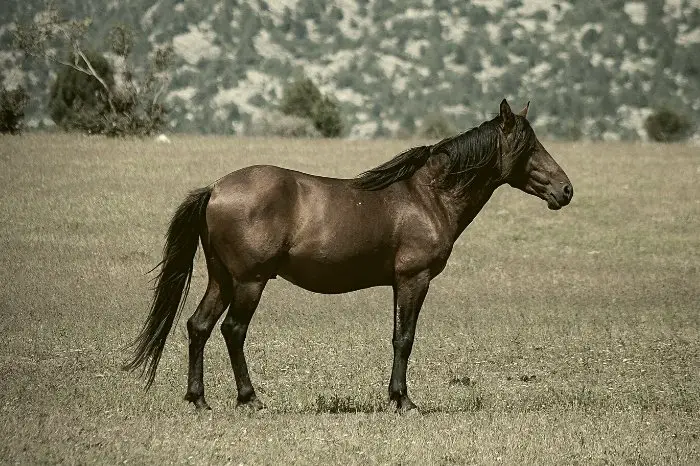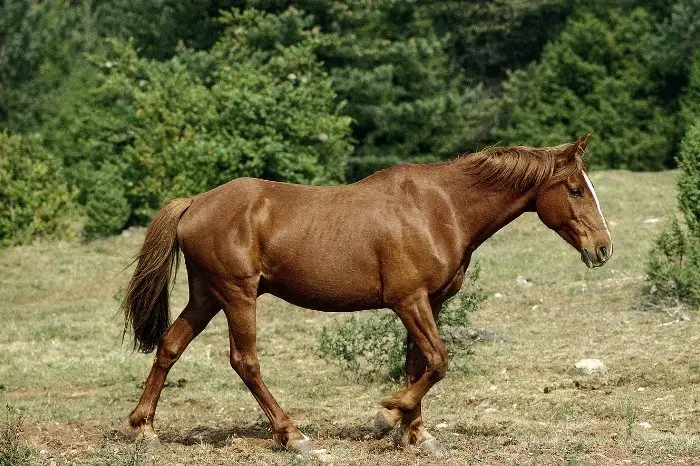Last Updated on March 10, 2023
Have you ever wondered what types of horses were used in Medieval times? Was a Medieval courser horse used for battle, or on farms? Or did they have another purpose?
What is a Courser Horse?
In Medieval times, the use of horses in battle rose in popularity. It was thought that the combination of a horse and rider could equal ten men on foot, and medieval horse stables were soon filled with horses being trained for battle or defense.
The name ‘Courser’ is a medieval name for horses of a particular type, not a specific breed. There were two other types of horses used, the ‘Destrier’ and ‘Palfrey’. To understand what a Medieval courser horse is, it helps if we learn about all three types.

-
Courser
Courser-type horses were bred for speed and stamina. It is thought that they were descended from hot-blooded breeds such as the Arabian, Turkish, and Barb horses.
Many courser horses originated from the kingdom of Naples. Horses acquired from Africa were bred with European stock to create an extremely fast mount that could accelerate and change direction quickly.
These horses were lean and lithe, very different from the thickset mounts that were commonly used across Europe. The course horse quickly became very desirable, and these speedy horses were sought by kings across Europe, from as far away as England.
Due to their rarity and exotic bloodlines, courser horses were very expensive. They were owned mainly by the gentry and noblemen and were not affordable for everyday farmers and local landowners.
-
Destrier
The destrier was the original warhorse of Northern Europe, designed to be strong and fearless in battle. They were thought to be 14-16 hands high, similar in build to a modern-day hunting horse. This was a large and strong type of horse, with incredible agility and stamina.
Destriers were trained from a young age, and tradition dictated that they were trained by the rider who would take them into battle. They were taught to be fearless in the face of humans, creating a horse that would charge into battle.
A destrier horse was very expensive and highly sought after. Their sole purpose was a battle horse, and they were normally owned by the wealthiest knights and royalty. Royal studs were set up to breed the very best war horses, often importing larger horses from abroad to improve the size and strength of the bloodlines.
In the 1500s, King Henry VIII of England strived to increase the size of English horses, which were quite small up to this point. He passed laws that decreed that at least two large mares must be kept by major landowners, and stallions were banned from grazing on public lands if they were too small. While the aim was to breed larger horses for battle, King Henry VIII was also a sizable man, and so needed horses of a certain size to carry him!
It is believed that modern-day draft horses are from destrier bloodlines, however, they are much larger and slower than their noble war horse ancestors.
-
Palfrey
The palfrey was a gaited horse, designed to be a comfortable ride over long distances. They had a peculiar four-time rhythm to their gait, which enabled them to cover ground quickly without causing discomfort to the rider.
Palfrey horses were very expensive and were generally only owned by the nobility. They were highly desirable as mounts for ladies, as they were more comfortable to ride. This type of horse would not have been commonly used in battle.
-
Rouncy
The rouncy was an all-purpose horse, used for battle as well as everyday riding. These types of horses were ridden by less wealthy knights and squires, who needed a horse suitable for battle but could not afford a destrier horse.
A commoner who could afford a horse such as a rouncy would have been able to use it to work on the farm, as well as for riding. Then, if called into battle, the rouncy would have been used for a battle mount as well.
Because they did not have the intensive training of the destrier horse, the rouncy was not such a reliable or tough battle mount.
The Medieval Horse and its Equipment, c.1150-1450
What Was The Purpose of a Medieval Courser Horse?
So, we have the destrier horse which was designed for war, and the palfrey horse for comfort. The rouncy falls midway between the two, but what was the purpose of the courser horse?
The medieval courser horse was built for speed and endurance, able to cover ground quickly and travel for long distances. This meant that they were highly sought after as mounts for messengers, able to rapidly carry messages between kingdoms or armies. They were also used in battle when the rider needed a mount that could outrun other horses and change direction quickly.
It is believed that some courser horses may even be the ancestors of modern-day racehorses such as Thoroughbreds.
Medieval courser horses were only owned by nobility and gentry and were highly prized possessions.
Learn more about War Horses – Top Breeds Revealed!
Can I Buy a Medieval Courser Horse?
The courser horse itself was not an actual breed, but a type of horse. In modern times, you will not find a horse for sale that is described as a courser horse. Thankfully, there is no need for them in modern society!
However, you could attempt to find a horse that has similar breeding to a courser horse. We know that they were normally a cross between two district breeds. So, all we need to do is track down a horse with similar bloodlines.
The first of these was a hot-blooded horse, normally an Arabian, Turkish, or Barb horse. The most common of these now is the Arabian, and they are often crossed with other breeds. This is because people desire their speed and stamina, but like to cross this with the level-headed mindset of calmer breeds.

The other half of a courser horse breeding was normally a European riding horse. At this time, most horses were descended from farm stock, and used for heavy labor. This meant that they were what we describe as a cold-blooded breed.
European horses would have been well-built and strong, with a calm and placid nature. When crossed with a fiery Arabian, this would create a horse with speed and endurance and dependable nature. In modern terms, the courser would be a warm-blooded breed of horse.
To get a similar cross, we would need to find a European horse breed similar to the ones used to create the courser. A good example would be the Friesian horse, used in Medieval times as a war horse for the crusades. The Friesian breed is strong and athletic, with considerable agility and stamina.
How Big Was a Medieval War Horse?
If you were to believe the movies, the battle horses used in medieval times were giants! Films tend to depict knights and cavalry riding huge 16hh plus horses, but was this the case in real life?
Studies have shown that most medieval war horses were much smaller than this, and the vast majority were no bigger than ponies! So, while the cinema industry may prefer to show knights riding majestic war horses, in reality, it is more likely that they were mounted on much smaller ponies.
Over time, the size of horses has gradually increased through selective breeding. Royal stables would breed battle horses primarily for their strength, stamina, and speed, but the size of horses did get bigger over time. Eventually, the largest war horses would go on to become the ancestors of many of our modern-day horse breeds, particularly draft horses such as Percherons and Shire horses.
Did Medieval War Horses Wear Armor?
Like the knights that rode them, medieval war horses needed protection from injury in battle. These horses would wear various pieces of steel armor over different parts of the body, which would weigh up to 50 pounds in total. On top of this, they had to carry a rider who would also be wearing heavy armor, so these horses needed to be very strong indeed!
Armor worn by medieval battle horses included a chanfon, a shaped metal plate that covered the horse’s head. This would normally be embellished with the family crest or coat of arms of the knight riding the horse.
Along the neck, the horse would wear a series of overlapping plates, called a crinket. The rump was covered in a rounded sheet of armor called a crupper, and the chest was protected by a flared metal sheet called a peytral. The final piece of armor was placed around the saddle area to protect the rider from flying spears, arrows, and lancets.
Summary
So, as we have learned, Medieval courser horses could run very fast and were used to deliver messages during Medieval times. This was especially important during battles when information needed to be passed on quickly. It is believed that the courser horse could be the ancestors of modern-day Thoroughbreds.
We would love to hear your thoughts about courser horses – would your horse have the stamina to gallop between kingdoms? Perhaps you know some more interesting facts about Medieval battle horses? Add a comment below this post and we’ll get back to you!

Kate Chalmers is a qualified veterinary nurse who has specialized in horse care for the vast majority of her career. She has been around horses since she was a child, starting out riding ponies and helping out at the local stables before going on to college to study Horse Care & Management. She has backed and trained many horses during her lifetime and competed in various equestrian sports at different levels.
After Kate qualified as a veterinary nurse, she provided nursing care to the patients of a large equine veterinary hospital for many years. She then went on to teach horse care and veterinary nursing at one of the top colleges in the country. This has led to an in-depth knowledge of the care needs of horses and their various medical ailments, as well as a life-long passion for educating horse owners on how to provide the best possible care for their four-legged friends.
Kate Chalmers BSc (Hons) CVN, Dip AVN (Equine) Dip HE CVN EVN VN A1 PGCE

